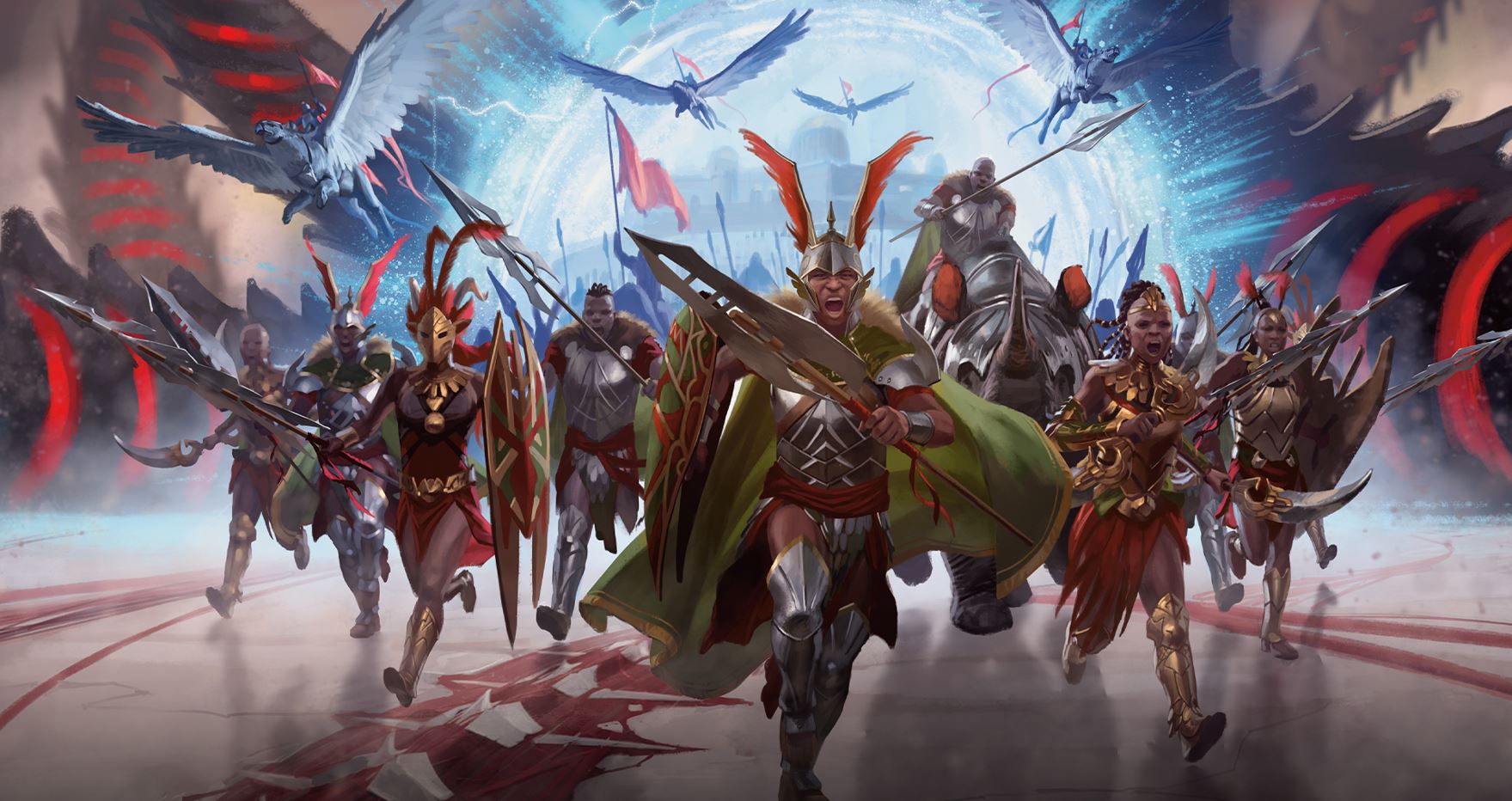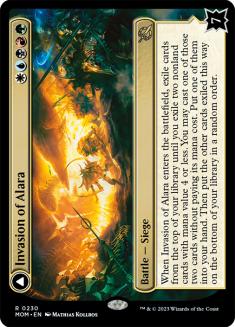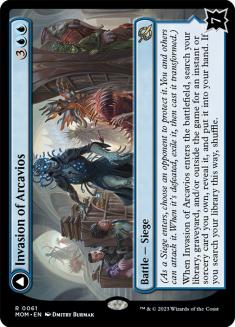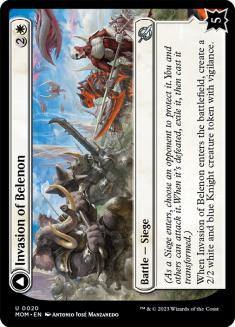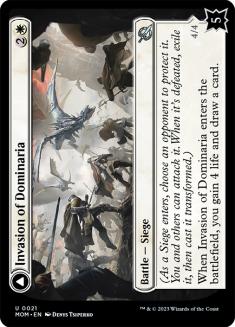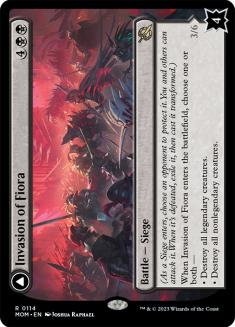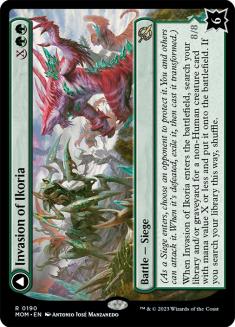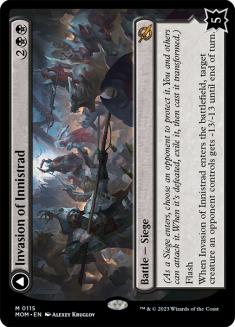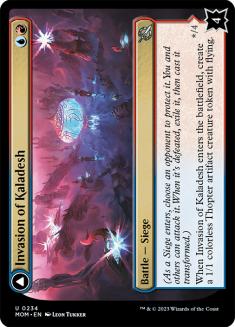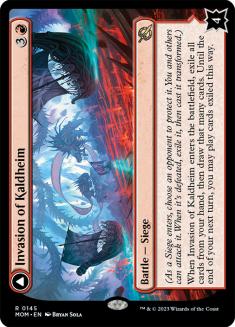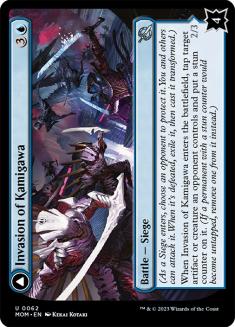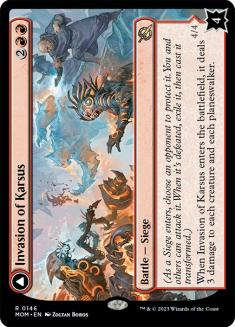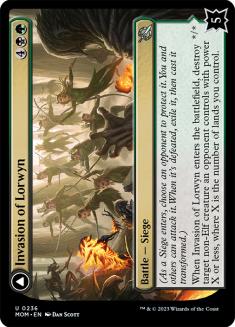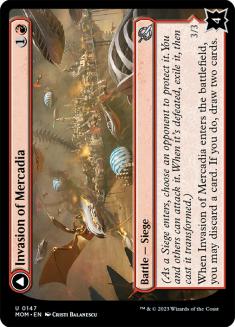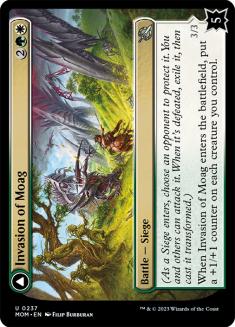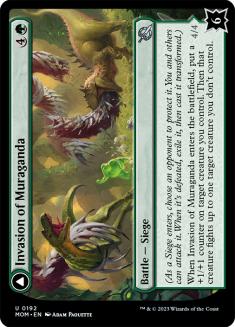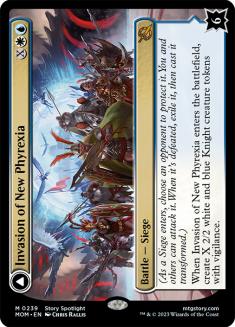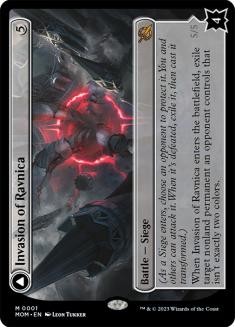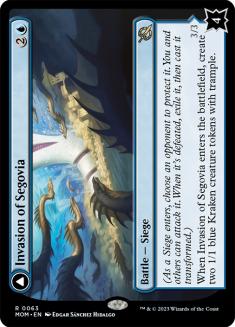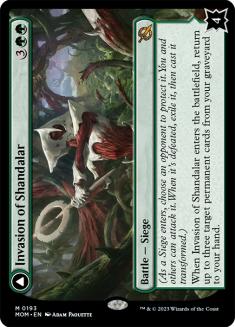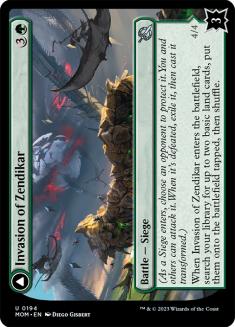A new permanent type has arrived in Magic, and it promises to get the combat juices flowing wherever it appears. Welcome to battles, which are cards we cast on their front side. We’ll get an ability, and then the action really starts. They enter the battlefield with a number of defense counters, kind of like loyalty counters on planeswalkers; from what we’ve seen so far, they don’t do anything other than provide a defense number.
We then choose an opponent to defend the battle, who most importantly can block for it. Everyone else can attack it. Direct damage also works against depleting a battle’s defense. When the last defense counter is removed, the battle is defeated, and the owner casts it transformed (regardless of who defeated it). Since it’s cast, it can be countered and interacted with in other ways. If a battle is destroyed in some other way, like with Vindicate, it doesn’t transform.
All the battles we’ve seen so far have the subtype Siege, which implies that we might see different kinds of battles down the road. Currently, they transform into sorceries, creatures, enchantments, artifacts, and in one case a planeswalker. There’s every reason to believe that they could also transform into other card types in the future.
The Upside of Battles
There are two main upsides to battles. First is that even if we never defeat a battle, we’ve already gotten the initial ability to do something. They seem reasonably cost-appropriate, so it’s not like we’ve lost much. Of course, the reason we’ve played them it really to get the other side as well, since that’s the prime real estate.
The second benefit I see is that they circumvent certain counterspells which target types of cards. If our opponents are playing old classics like Remove Soul, Exclude, or Essence Backlash, they won’t do anything against a battle. We’ll be able to defeat the battle and get our creature going despite hostile countermagic.
A minor benefit is that the battles can’t really fight back. Sure, the player chosen to protect a battle can, but they’ll be less incentivized to do so in Commander because they still have to defend against two other players besides you. We’ll have to choose our defenders well, though. We can select the player already light on resources. We probably don’t want to give the job to the player with the creature-heavy deck.
After we get around the defender, the battle itself is at our mercy. We’re dealing damage to it, so attacking it with a creature that has lifelink seems grand. We’ll gain the life, but don’t risk losing our creature. It’s all upside. We can also swing wide with lots of small creatures, which is in effect trading up a little thing for something big.
The Complication
A potential wrinkle is that we’re committing resources to getting the battle defeated, resources that we don’t be directly throwing at our opponents. We’ll have to ensure the upside is worth it. The idea seems okay since we don’t have to commit mana to the effort, meaning that we’ll have a full tank for casting other spells on the turn we’re crashing the Siege.
Before we get to them mechanically, we’re on outstanding footing with great flavor, as they’re all (except one) named after the Phyrexian invasion of particular planes. The rewards are similarly plane-appropriate. Let’s take a look at some of the individual cards we’ve seen so far.
Invasion of Alara
Making sense at costing WUBRG given the setting, our five mana lets us exile cards from the top of our library until we get two of them with mana value four or less. We can put one into our hand and may cast the one without paying its mana cost.
Once we’ve defeated its hefty defense value of seven, we get a sorcery aptly named Awaken the Maelstrom, because lots of stuff happens. Remember that when a card gives us multiple instructions, we follow them in exact order as written on the card. An earlier one can have impact on a later one, like Awaken the Maelstrom does in multiple places. A target player draws two cards and we may put an artifact card from our hand onto the battlefield. We can then create a token that’s a copy of a target permanent we control. After that, we distribute three +1/+1 counters among one, two, or three of our creatures. Finally, we destroy a target permanent an opponent controls. This seems like an appropriately large payoff for our investment and could be a big game-swinger.
Invasion of Arcavios
Off to Strixhaven, we search our library or graveyard for an instant or sorcery that we own, reveal it, and put it into our hand. The card also mentions searching outside the game—which is likely why the mana cost is a somewhat-spendy five mana. In Commander, that part of the card doesn’t work due to Rule 10, but the rest of it does.
While the front side investment is high, the back side—once again through a defense of seven—is well worth it. We get Invocation of the Founders, an enchantment which will copy every instant or sorcery spell we cast from our hand (and choose new targets for the copy, per usual). That’s right, no first or second spell we cast. Copy every one of them. The value proposition alone is good enough without even thinking about combos and win cons. Arcavios gets there.
Invasion of Belenon
A simple five-defense battle, Invasion of Belenon gives us something to enter the Siege with, a 2/2 white and blue Knight with vigilance. The defense is five, after which we get Belenon War Anthem, an enchantment simply granting all our creatures +1/+1. Other than keeping the Knight, this one seems more efficient if we just cast other Anthems.
Invasion of Dominaria
Another pretty straightforward one, we gain four life and draw a card for 2W, a decent rate. The five defense yields a 4/4 flying, vigilance creature called Serra Faithkeeper. At the same cost to cast as Invasion of Belenon, I’m a much bigger fan of heading to Dominaria.
Invasion of Fiora
Hefty to cast at 4BB, Invasion of Fiora will absolutely end up worth it. When the battle comes in, we have the choice of either destroying all legendary creatures or all nonlegendary creatures. Once again, note the way battles work. The spell is the battle. The effect is a triggered ability. Our opponents won’t know which mode we’re choosing until we put the triggered ability on the stack, although I suppose there’s some political play likely to happen here.
The defense is a lowly four, and then it’s really on with one of my favorite characters—in this case, a legendary Human Noble named Marchesa, Resolute Monarch (long may she reign). She’s a 3/6, and when she attacks, we can remove all counters from up to one target permanent. Most of you are already thinking Dark Depths. I’m also thinking about removing the age counters from Glacial Chasm or yoinking everything off an opponent’s planeswalker.
Marchesa also has a beginning-of-upkeep trigger, which is true to her form and reflects her disdain for other people’s combats. If we haven’t been dealt combat damage since our last turn, we draw a card and lose a life. My Marchesa, Long May She Reign deck likes to become the monarch and keep it that way, so this card will slot right in.
Invasion of Ikoria
We head to Ikoria for a convokeless Chord of Calling variant costing XGG, which allows us to search our library—and the important upgrade—also our graveyard for a non-Human creature (It’s Ikoria, remember?) with mana value X or less and put it onto the battlefield. That already seems good enough. If we can bust through the defense of six, we end up with Zilortha, Apex of Ikoria, an 8/8 Dinosaur with reach. Its ability, however, is the one that will likely have it aggressively defended: we can have each non-Human we control assign its combat damage as though it weren’t blocked. This is extremely important for a Dinosaur like Gishath, Sun’s Avatar, getting every last drop of that damage in.
Invasion of Innistrad
You knew we were headed here, and it’s definitely full of flavor. It has flash and when it enters the battlefield, we give target creature an opponent controls -13/-13 until end of turn. Take that, Ulamog! Defeated at five, we get Deluge of the Dead, an enchantment that creatures two 2/2 Zombie tokens when it enters the battlefield. It also offers some graveyard control, exiling a card from a graveyard for 2B and giving us another Zombie if it was a creature card. Solid and useful.
Invasion of Kaladesh
The least expensive of the battles at UR, Invasion of Kaladesh gives us a 1/1Thopter when it enters the battlefield. Its defense of four gives way to a legendary artifact Vehicle called Aetherwing, Gold-Scale Flagship, which flies and has a toughness of four and power equal to the number of artifacts we control—and the insanely low crew cost of one. Faces will get smashed here.
Invasion of Kaldheim
Kind of a cool take on bottling, the triggered ability of Invasion of Kaldheim has us exile the cards in our hand, then draw that many cards. We can until end of turn to play the cards that have been exiled in this way. Nice that it refills the hand. Then we find out why. When we’ve banged through the defense of four, we find the smoldering Pyre of the World Tree, an enchantment akin to Land’s Edge with upside. We can activate it by discarding a land, dealing two damage to any target. Then it has a triggered ability whenever we discard a land to bottle the top card of our library (meaning we exile it and can play it this turn). I might like it just for that trigger alone.
Invasion of Kamigawa
I guess Kamigawa is about going to value town now. For 3U, we tap and stun an artifact or creature an opponent controls. Coming back after a defense of four as the 2/3 Moonfolk Ninja Rooftop Saboteurs, we have a nice triggered ability. Whenever Rooftop Saboteurs deals combat damage to a player or battle, we draw a card. Being able to get card advantage from the lower-risk proposition of attacking a battle grows our hand in short order.
Invasion of Karsus
The flames come out as Invasion of Karsus deals three damage to each creature and planeswalker when it enters the battlefield. When we overcome the defense of four, was can cast Refraction Elemental, a 4/4 Elemental with Ward—Pay 2 life. It has a combo-tastic triggered ability of dealing three damage to each opponent whenever we cast a spell. Invasion of Karsus produces a great deal of damage for very little effort. Light the fires!
Invasion of Lorwyn
When you think about it from a flavor perspective, you realize what the 4BG Invasion of Lorwyn is going to do. When it enters, it destroys a target non-Elf creature an opponent controls with power X or less, where X is the number of lands we control. Our number of lands stays relevant once we defeat the five and turn into Winnowing Forces, whose power and toughness are in Dakkon Blackblade land. I’d like it to have some evasion, but we can get that in both of our colors, so should be easy.
Invasion of Mercadia
I’ll be honest, I was hoping for some variant of Mercadia’s Downfall. For the low price of 1R, we can discard a card when the battle enters; if we do, we draw two cards. The transformed side is Kyren Flamewright, a 3/3 Goblin Spellshaper which follows the discard theme. For 2R, tap, and discarding a card, we create two 1/1 blue and red Elemental tokens and our creatures get +1/+0 and haste until end of turn. Maybe we can use them to go wide and attack some other battle.
Invasion of Moag
Conditionally very explosive. We put a +1/+1 counter on each creature we control when Invasion of Moag enters. We’ll need those counters to get through the defense of five, eventually netting us the 3/3 Bloomweaver Dryads, which has ward 2 and an end step trigger to put a +1/+1 counter on target creature we control. It’s the kind of little thing you slip into a Naya deck that also carries All Will Be One.
Invasion of Muraganda
A biggie that might get people a little more excited about the fight mechanic, when Invasion of Muraganda comes along, we put a +1/+1 counter on a target creature we control, then that creature fights up to one target creature we don’t control. We’ll need to have cleared the way, since this battle’s defense is six.
Once we knock it down, we’ll get Primordial Plasm, a 4/4 Ooze with a beginning-of-combat trigger. It’s one that could be used in straightforward fashion or more creatively. Another target creature gets +2/+2 and loses all abilities until end of turn. While we normally want to buff our own creatures, the ability loss becomes problematic. Losing abilities isn’t so bad if we target an opponent’s creature—like if it’s their last flyer, or it has hexproof and we really want to target it.
Invasion of New Phyrexia
What we suspect is the crown jewel of the battles, since it turns into a planeswalker, Invasion of New Phyrexia starts out costing XUW and creating X 2/2 white and blue Knight tokens with vigilance. We should then be able to swing around the defense of six (if we’re not just killing someone) to cast Teferi Akosa of Zhalfir. All three abilities are relevant. The +1 draws two cards, then discards two unless we discard a creature card. The -2 grants an emblem giving our Knights +1/+0 and ward 1. If we can activate that ability again, they’ll be cumulative.
The -3 ability is unusual. On resolution, we tap X creatures we control. When we do (so setting up another triggered ability), we can shuffle target nonland permanent an opponent controls with mana value X or less into its owner’s library. We could get rid of something that’s been plaguing us, or we can bring back home something that someone has stolen from us. The cost is going to be quite high since we’re doing this at sorcery speed, but I guess that’s what all those Knights are for.
Invasion of Ravnica
As spicy as they come and probably going into fellow Commander RC member Toby Elliott’s Niv-Mizzet Reborn deck, when the colorless Invasion of Ravnica enters the battlefield, we exile target nonland permanent an opponent controls that isn’t exactly two colors. We have to keep our hands off the guilds, but everything else is fair game. It will eventually become Guildpact Paragon, which will look for guild spells. When we cast one that’s exactly two colors, we can look at the top six cards of our library, reveal one that’s exactly two colors, and put it in our hand. The rest go to the bottom of the library in any order. I think I’ll be playing Invasion of Ravnica in a deck where I can simply blink it in (remember that things will always come back on their front faces).
Invasion of Segovia
At first, we get two adorable 1/1 Kraken tokens with trample. When we get to the other side, things start to really roll. It becomes a 3/3 Legendary Serpent names Caetus, Sea Tyrant of Segovia. Its static ability is giving all our noncreature spells convoke, which will certainly help us to cast some of those big sea monsters. At the beginning of our end step, we get to untap four creatures, giving us more convoke fuel. Love the synergy.
Invasion of Shandalar
Speaking of things you love to see, going back to Shandalar is all the feels about the first digital incarnation of our beloved game. It’s strong, befitting the positivity of those memories. When we first see it, we return up to three target permanents from our graveyard to our hand. We’ll need to pick carefully, since the transformed version, Leyline Surge, gives us a beginning-of-upkeep trigger to put a permanent card from our hand onto the battlefield. This is a battle worth fighting for.
Invasion of Tarkir
Just savage Dragon-themed damage, Invasion of Tarkir might do very little damage on the front side, since we have to reveal Dragons to get extra damage after the first two. On the flip side (that takes five to get through), however, whenever a Dragon we control attacks, it deals two damage to any target. It’s a way of clearing away chump blockers, or maybe by ganging up all the triggers on a single one. Any way we look at it (and peering though the lens of Fiery Emancipation would be cool), stuff is getting roasted on Tarkir.
Invasion of Tolvada
Exactly what I want an Orzhov card to do when it enters the battlefield, Invasion of Tolvada reanimates a nonbattle permanent from our graveyard. We can use that big thing to get through the defense of five, casting an enchantment called The Broken Sky. Creature tokens we control (like, say, Inklings) get +1/+0 and lifelink. At the beginning of our end step, we create a 1/1 white and black Spirit token (and a missed opportunity to create more Inklings).
Invasion of Zendikar
Explosive Vegetation on a battle is good. The low defense of three gets us quickly to a 4/4 Elemental called Awakened Skyclave, which on the battlefield is a land in addition to its other types. It has vigilance and haste, and the ability to tap for a mana of any color. I think I prefer my 4/4s getting into combat, but extra mana rarely hurts.
Further Notes
One more rules thing I want to point out about battles is that those defense values are counters in every way you’re used to counters existing in the game. Importantly, they can be removed, and more relevantly, your opponents’ can be proliferated, making it harder for them to defeat. I absolutely love this extra level of gamesmanship that come along with battles.
There might be Magic purists who aren’t fond of the side quests that Magic designers have come up with over the years. I’m not one of them. Fun things like dungeons and battles excite me. One of the reasons Commander was created with a 100-card singleton deck is so that variance can have its spot in the sun. Battles are simply another way in which it can blaze brighter.
Always remember, we have a channel on the Commander RC Discord server dedicated to discussing my articles. I’d love to hear about features that you’d like to see, material you want more coverage on, ideas for subscriber/Patreon benefits you’d like to see, or even things that you think just aren’t working—especially now that our revamped Patreon is live and ready to engage you with new benefits!. Join nearly 10,000 friends for discussion of not just this piece, but on a wide variety of topics—both Commander-related and not. See you there!
Visit my Decklist Database to see my Signature Decks, the Chromatic Project, and more!

